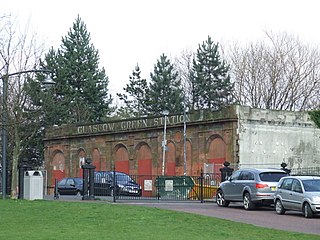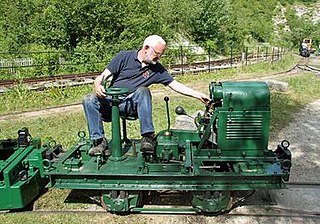Related Research Articles

Maryhill is an area of the City of Glasgow in Scotland. Maryhill is a former burgh. Maryhill stretches over 7 miles (11 km) along Maryhill Road. The Maryhill district has several sub-districts, such as Acre, Botany, Dawsholm Park, Firhill, Gairbraid, Gilshochill, Maryhill Park, North Kelvinside, Queens Cross, St George's Cross, Cadder, Summerston, Woodside and Wyndford.

Cowlairs Locomotive, Carriage and Wagon Works , at Cowlairs in Springburn, an area in the north-east of Glasgow, Scotland, was built in 1841 for the Edinburgh and Glasgow Railway and was taken over by the North British Railway (NBR) in 1865. It was named after the nearby mansion of Cowlairs, with both locomotive and carriage & wagon works. It was also the first works in Britain to build locomotives, carriages and wagons in the same place. It was located on the western side of the Glasgow-Edinburgh mainline at Carlisle Street.

Kelvindale railway station is a railway station that serves the Kelvindale suburb of Glasgow, Scotland. It was opened on 26 September 2005 by Bill Butler, the then Member of Parliament in the Scottish Parliament and Councillor Alistair Watson. A bronze plaque records the event. The station is 5 1⁄2 miles (8.9 km) north of Glasgow Queen Street on the Maryhill Line.
Whiteinch Victoria Park railway station was a suburban railway station serving Whiteinch in Glasgow, Scotland. It was opened as a goods station known as Whiteinch in 1874 as part of the newly constructed Whiteinch Railway. In 1897, the station was rebuilt as Whiteinch Victoria Park, with services running to Jordanhill railway station. However, the passenger service was terminated in 1951. It remained in use for goods and as a depot during the electrification of other routes in the area, finally closing in 1967.
The Glasgow Central Railway was a railway line built in Glasgow, Scotland by the Caledonian Railway, running in tunnel east to west through the city centre. It was opened in stages from 1894 and opened up new journey opportunities for passengers and enabled the Caledonian Railway to access docks and industrial locations on the north bank of the River Clyde. An intensive and popular train service was operated, but the long tunnel sections with frequent steam trains were smoky and heartily disliked.
Parkhead Stadium was a railway station in the east end of Glasgow. It was opened by the Caledonian Railway as Parkhead on 1 February 1897.

Glasgow Green was a railway station in the east end of Glasgow, Scotland.

Kirklee railway station was a railway station serving the Kelvinside area in the West End of Glasgow.

Maryhill Central was a railway station to the north west of Glasgow.
The Hillend Loch Railway Path, also known as the Airdrie to Bathgate Railway Path, is a rail trail located in central Scotland. The path is approximately 14 miles (23 km) long and follows the route of the former Bathgate and Coatbridge Railway between Airdrie, North Lanarkshire (55.8662°N 3.9539°W), and Bathgate, West Lothian (55.8918°N 3.6224°W).

Marlands Works was a busy industrial site for just over a century, firstly on the Torrington and Marland Railway, built to carry bricks and clay on a three-feet gauge, which in turn was subsumed in 1925 by the North Devon and Cornwall Junction Light Railway before finally becoming part of the Southern Region of British Railways in 1948. The line closed to passenger traffic in 1965 as part of the Beeching reforms but the line remained open for freight between Barnstaple railway station and Torrington until 1982. Today it forms part of the popular Tarka trail, although an important site for industrial railway historians too. Marland Works station was used by workmen only and was not in public passenger use.

St. Leonards railway station is a closed railway station on the Edinburgh and Dalkeith Railway. It was Edinburgh's first railway station. The railway was built in 1831 to transport coal from the mining towns south of the city; and the following year opened passenger services. St. Leonards was the terminus for the south of the city and was named after the nearby region.

Earlston railway station, in the Scottish Borders village of Earlston, was a station on the now disused Berwickshire Railway.There were two platforms and two sidings, cattle dock and goods shed. The station closed to passenger traffic in 1948, and the last freight service operated on Friday 16 July 1965. The station closed completely, along with the line, on Monday 19 July 1965.

Carronbridge railway station was a railway station in Dumfries and Galloway north of Dumfries, serving the village of Carronbridge and district. The station was opened as Carron Bridge Station and was renamed Carronbridge Station on 1 January 1871.

Ryeland was a railway station on the Darvel and Strathaven Railway serving a rural area in South Lanarkshire, Scotland.
Strathaven Central or Strathaven was a railway station on the Darvel and Strathaven Railway serving the town of Strathaven in South Lanarkshire, Scotland. The station opened as an extension of the line from Stonehouse and in 1904 was connected with the Hamilton and Strathaven Railway via a link to Strathaven North. It was renamed as 'Strathaven' a few months before closure.
Wark railway station is a disused railway station which served the village of Wark on Tyne, Northumberland, England. Located on the Border Counties Railway, the station was possibly opened on 1 December 1859, but was definitely open by 1 April 1860. The station was originally connected to the village by a wooden bridge over the River Tyne but this was replaced by an iron bridge in 1878. There was a single platform, a small goods shed with a signal box being added in 1896. It was closed to passengers on 15 October 1956 and completely on 1 September 1958.

Gallowgate railway station was a station in Glasgow, Scotland. It was situated a short distance east of Glasgow Cross at the junction of East Nile Street, today Molendinar Street.

Garngad railway station was a railway station in Royston, Glasgow on the City Union Line, on the Garngad chord. It closed for passenger traffic in 1910.

Lenzie Peat Railway was a narrow-gauge railway which ran on Lenzie Moss, which is situated to the west of the town of Lenzie in Scotland.
References
| Preceding station | Historical railways | Following station | ||
|---|---|---|---|---|
| Kirklee | Caledonian Railway Glasgow Central Railway | Terminus | ||
Coordinates: 55°53′30″N4°18′01″W / 55.8918°N 4.3002°W
| This Glasgow railway station-related article is a stub. You can help Wikipedia by expanding it. |